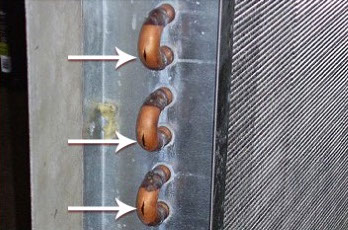You have questions… we have solutions! Here you will find HX Coils most often asked questions and our provided answers. Don’t see what you’re looking for? Give us a call and we can help you find the right solution for your all your heat transfer equipment needs.
It’s a good idea to check your coils before the heating and cooling season — especially if the coils are located near the outside air inlet dampers. A number of seemingly small items can lead to inefficiencies in the system and create havoc on the coils.
FOR COIL QUESTIONS, CALL THE EXPERTS AT HX COILS.
When designing coils for a specific system, we frequently refer to “the hand of the coil”. What we are asking is if it is a left hand coil or right hand coil.
To determine the hand of the coil:
The goal is to achieve the greatest temperature differential between the entering air and the cooling medium as possible — and accomplish this with efficiency. Knowing the hand of the coil allows you to make sure the air and the cooling medium are moving in opposite directions giving you the greatest opportunity for temperature difference.
Knowing the number of tubes in one row vs. how many tubes in that same row are being fed from the supply header will give you the circuitry. For example:
| Full Circuit Coil | 20 tubes in a row (20 tubes are fed from the supply header) |
| Half Circuit Coil | 20 tubes in a row (10 tubes are fed from the supply header) |
| Quarter Circuit Coil | 20 tubes in a row (5 tubes are fed from the supply header) |
| Double Circuit Coil | 20 tubes in 1st row :: 20 tubes in 2nd row (all tubes in both rows are fed from the supply header) |
The faster the fluid velocity, the higher the coil capacity, however, the higher the air velocity, the lower the coil capacity. Care must be taken when selecting replacement coils to ensure that the new coil velocities matches the coil being replaced. It is important to have the original design data (when available) to ensure that the capacity will be as close to what was intended.
Fans are selected for their ability to deliver a specific volume of air at a given pressure drop (resistance). One of the components considered in the calculation of the overall system pressure drop is the coil. When specifying a replacement coil, it is critical that the new coil will not significantly increase the pressure drop. Simply stated, if the coil surface area is reduced (resulting in higher air velocities) or the silhouette of the fin is increased (higher corrugation), the pressure drop may increase to a point where the fan can no longer overcome the static resistance that the fan was originally designed to handle. This can result in a drastic reduction of performance, higher leaving air temperatures in a cooling coil and lower air temperatures in a heating coil.
In a cooling coil application, moisture carryover (or sometimes called water blow off) happens when the air velocity is too high creating the potential for water that has condensed on the surface of the cooling coil to blow off and travel down the airstream. Excessive moisture in the airstream can cause a whole host of unwanted water related issues. As a general rule, try to avoid air velocities over 500 fpm. In some cases, coated coils can produce blow off in velocities under 500 feet per minute. To maximize performance and minimize problems, consult with HX Coils when it comes to designing or replacing your coils.
When selecting material gauges, the biggest consideration is the ability of a coil to withstand the rigorous cleanings performed by pressurized air and water. These cleanings can wear down the materials over time. The maintenance and cleaning schedule required for the heat transfer equipment for the system should be a high consideration for the new or replacement heat transfer equipment purchased.
When selecting tube wall thickness, a thinner tube wall reduces the landed surface of the “tube to header joint”. Luvata/Heatcraft manufactures their line of heat exchangers with the tube intruding into the header prior to brazing at a measurement of 2½ times the tube wall thickness. This increases the landed surface to be brazed to the header.
The result is more dependable, longer lasting joints between the header and the tubes, and between the tubes and return bends that are less susceptible to premature failure.
Tube wall thickness is also a consideration for shell and tube heat exchangers. In most cases the tubes are expanded to the tubes sheet, (not brazed), and the thicker tube wall results in a stronger bond yielding a longer life.
A bulging of the tubes with subsequent splits is a telltale sign of failure caused by freezing. When water or condensate is held at ambient temperatures of 32°F or less, the tubes can freeze and expand. This can lead the internal coil pressure to reach dangerous levels. Or, a fan delivering cold air across the coil surface can wreak havoc and cause irreparable coil damage very quickly. Freeze damage is one of the leading causes of steam and water coil failure. Check your coils regularly no matter what—but especially during severe temperature conditions.
